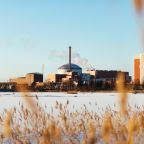Search results
The percentage of nuclear energy in the global electricity mix has been fairly stable between 10 and 11 per cent in recent years, but fell below the 10 per cent mark in 2022 for the first time in 40 years. Nevertheless, reactors are being built in a number of countries, new reactor concepts are being developed and the operating lives of existing reactors are being extended. The most important argument is usually the low CO2 balance of the base-load energy form. With our country dossiers, which we will publish here in the coming weeks and months, we would like to give an overview of the current developments in Europe and neighbouring countries. A good introduction and overview of the overall situation is provided by our dossier "Nuclear Energy Worldwide", which we update at the beginning of each year.
What has happened in the field of nuclear energy last year? What developments can be observed internationally? As in the previous year, in 2022, a total of six new reactor units were connected to the grid. On the other hand, five units have been decommissioned, three of them in the UK alone. Accordingly, the installed net electrical capacity increased by 4,089 MW to 378,314 MW.
One of our job advertisements appealed to you and you would like to apply for a job with us? Then we look forward to getting to know you! On this page, we have compiled all the important information that is important for you now.
Many renewable energies feed electricity into the grid dependent on wind and weather. If the amount of energy generated in this way is higher than the demand, there is an oversupply. If the power grids cannot absorb the oversupply, it frequently happens that wind and solar power plants have to be shut down. Power-to-gas technology offers a way to convert surplus electricity into hydrogen by means of electrolysis.
Marina Röwekamp (GRS, Editor), Heinz-Peter Berg (Editor)
C.-L. Zhang, A. Rogalski, B. Zehle, U. Hertes
K.-P. Kröhn
On 26 April 1986, an accident with the most serious consequences in the history of the peaceful use of nuclear energy occurred in Unit 4 of the Chernobyl nuclear power plant in Ukraine. The course of events and causes of the accident are by now largely understood. However, the effects on people and the environment continue to this day. Recently, the site has been increasingly in the media again due to the Russian war of aggression.

On 16 April 2023 at 01:00 in the morning, just one hour after the final three German nuclear power plants (NPPs) were shut down, the Olkiluoto-3 NPP in Finland began commercial operation. The reactor now feeds the electricity it generates into the Finnish power grid at market conditions. This was preceded by commissioning work and a 30-day trial run. With an electrical output of 1,600 megawatts (MW net), the plant of the European Pressurised Water Reactor (EPR) type is the most powerful reactor in the world.
Gesellschaft für Anlagen- und Reaktorsicherheit (GRS) gGmbH